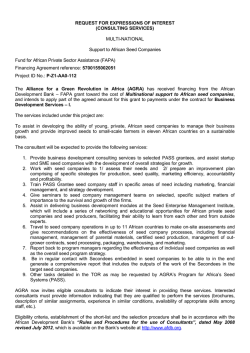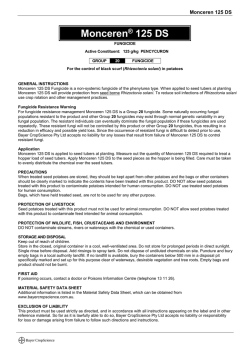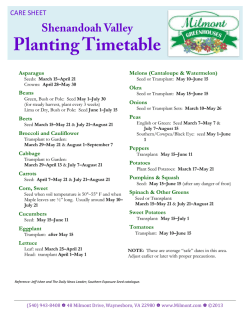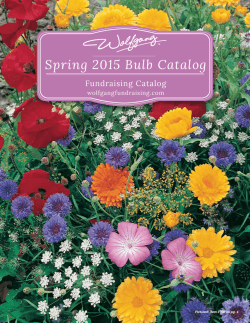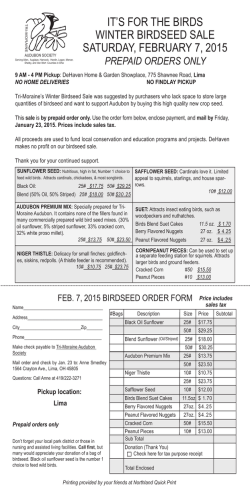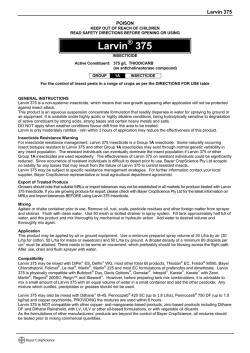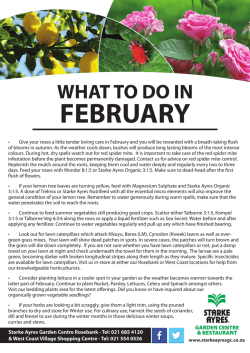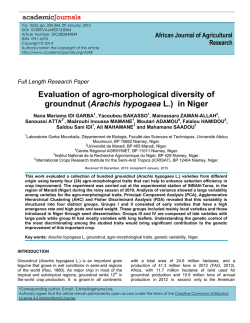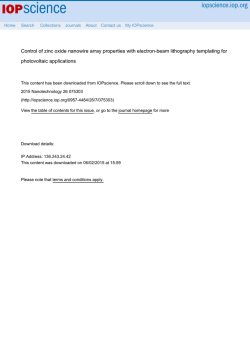
Poncho Plus web label
Poncho Plus POISON KEEP OUT OF REACH OF CHILDREN READ SAFETY DIRECTIONS BEFORE OPENING OR USING Poncho® Plus INSECTICIDAL SEED TREATMENT Active Constituent: 360 g/L CLOTHIANIDIN 240 g/L IMIDACLOPRID GROUP 4A INSECTICIDE For the control of various insect pests in a range of crops, as specified in the DIRECTIONS FOR USE table GENERAL INSTRUCTIONS Insecticide Resistance Warning For insecticide resistance management, Poncho Plus is a Group 4A insecticide. Some naturally occurring insect biotypes resistant to Poncho Plus and other Group 4A insecticides may exist through normal genetic variability in any insect population. The resistant individuals can eventually dominate the insect population if Poncho Plus and other Group 4A insecticides are used repeatedly. The effectiveness of Poncho Plus on resistant individuals could be significantly reduced. Since occurrence of resistant individuals is difficult to detect prior to use, Bayer CropScience accepts no liability for any losses that may result from the failure of Poncho Plus to control resistant insects. Poncho Plus may be subject to specific resistance management strategies. For further information contact your local supplier, Bayer CropScience representative or local agricultural department agronomist. Pasture seed, canola, forage brassicas, summer crops Mixing and seed treatment Prior to pouring, shake container vigorously, then add the required quantity of Poncho Plus to sufficient water to give even coverage of the seed to be treated. Place seed in mixing equipment and rotate. Mix Poncho Plus with sufficient water to give even coverage of seed and spray onto seed. The quantity of water used for mixing will vary depending on type of equipment and type of seed, refer to Bayer for specific treatment information. Store treated seed under cover in cool, dry conditions. Do not treat seed with poor viability. Do not store treated seed near foodstuffs or where likely to prove hazardous to humans or animals. Do not carry over maize, sorghum, sunflower or sweet corn seed from one season to the next season. The insecticidal activity of Poncho Plus on the seed is maintained for a minimum of 12 – 18 months. Flow rate Poncho Plus treated seed may slow flow rate of seed. Check flow rate of seed through sowing machinery before sowing to ensure the desired seeding rate is achieved. Seed quality Poncho Plus seed treatment should only be used on high quality seed which meets or exceeds accepted seed quality parameters. Treating with Poncho Plus as directed may raise the moisture level of the seed by up to 1.5%, depending on conditions at treatment. The use of Poncho Plus mixed with water at recommended rates will have no effect on the storage life of treated sound seed. Compatibility Poncho Plus is compatible with Thiram, and P-Pickle T® Liquid Fungicidal Seed Dressing for use. Do not use more than 600 mL of total mixture /100 kg seed (i.e. Poncho Plus + Thiram or P-Pickle T plus water). After treating seed with a mixture of Poncho Plus and P-Pickle T allow seed to dry. For information on the compatibility of Poncho Plus with other products, contact your local Bayer CropScience representative. Storage of treated seed Do not store treated seed near foodstuffs or where likely to prove hazardous to humans or animals. If the seed is not used immediately after treatment it should be stored in a dry, well ventilated place. Although Poncho Plus has no effect on the viability of treated seed, subsequent germination can be adversely affected by poor storage conditions such as high moisture combined with high temperatures. No liability can therefore be accepted for the performance of stored treated seed. PRECAUTIONS When treated seed is stored it should be kept apart from other grain and the bags or other containers should be clearly marked to indicate the contents have been treated with this product. Do NOT allow seed treated with this product to contaminate seed intended for human consumption. Do NOT use treated seed for human consumption. Bags which have held treated seed are not to be used for any other purpose. Poncho Plus Re-handling Do not allow re-handling of treated seed unless wearing cotton overalls, over normal clothing, buttoned to the neck and wrist and chemical resistant gloves. Clothing must be laundered after each day’s use PROTECTION OF LIVESTOCK Seed treated with this product must not be used for animal consumption or poultry feed or mixed with animal feed. Do NOT allow seed treated with this product to contaminate seed intended for animal consumption. PROTECTION OF WILDLIFE, FISH, CRUSTACEANS AND ENVIRONMENT Very toxic to aquatic life. DO NOT contaminate ponds, waterways and drains with this product, used containers or bags which have held treated seed. DO NOT feed treated seed or otherwise expose to wild or domestic birds. Any spillages of treated seed, however minor, must be cleaned up immediately, preferably by recovery and re-use. If disposal is required, ensure treated seed are thoroughly buried and not accessible to birds and other wildlife. PROTECTION OF BEES AND OTHER INSECT POLLINATORS This product is highly toxic to bees. Pollinators can be exposed to treated seed dust when it is carried by air or when it is deposited onto flowering crops, flowering weeds or water. Very dry and windy conditions can favour dust transport. For planters that discharge dust into the air, including those using pneumatic vacuum seed metering devices, deflector equipment should be installed to reduce emission of dust and the potential for off-field deposit of dust onto flowering crops or flowering weeds. For planters that discharge dust into the air, DO NOT perform seeding operations under very dry or windy conditions. STORAGE AND DISPOSAL Store in the closed, original container in a cool, well-ventilated area. Do not store for prolonged periods in direct sunlight. The method of disposal of the container depends on the container type. Read the STORAGE AND DISPOSAL instructions on the label that is attached to the container. SAFETY DIRECTIONS Harmful if swallowed. Harmful if inhaled. Avoid contact with skin. Do not inhale. When preparing the product for use and using the product, wear cotton overalls buttoned to the neck and wrist (or equivalent clothing) and a washable hat and elbow-length chemical resistant gloves. If product on skin, immediately wash area with soap and water. Wash hands after use. After each day’s use wash gloves and contaminated clothing. FIRST AID If poisoning occurs contact a doctor or Poisons Information Centre (telephone 13 11 26). SAFETY DATA SHEET Additional information is listed in the Safety Data Sheet, which can be obtained from your local Bayer CropScience representative. EXCLUSION OF LIABILITY This product must be used strictly as directed, and in accordance with all instructions appearing on the label and in other reference material. So far as it is lawfully able to do so, Bayer CropScience Pty Ltd accepts no liability or responsibility for loss or damage arising from failure to follow such directions and instructions. Poncho®, is a registered trademark of the Bayer Group. SeedGrowth™ is a trademark of the Bayer Group. APVMA Approval No 67779/56861 Poncho Plus DIRECTIONS FOR USE See GENERAL INSTRUCTIONS for specific application details CROP Canola, forage brassica PEST RATE 500 mL/ 100 kg seed CRITICAL COMMENTS Poncho Plus will provide protection from wireworm for 3-4 weeks after sowing. Poncho Plus will not protect seedlings from heavy wireworm populations and under these conditions an alternative control option should be considered. Poncho Plus will provide protection from cutworm for 3-4 weeks after sowing. Poncho Plus will provide protection from early season aphid damage for 3-4 weeks after sowing. Suppression only of lucerne flea. Poncho Plus will protect emerging seedlings from mite damage for 3-4 weeks after sowing. Monitoring should commence within this period to determine the need for supplementary control measures. Use Poncho Plus as part of an integrated mite management program which may include: For autumn sowing: After a pasture phase sow Poncho Plus treated seed following a well- timed spring insecticide spray (prior to the development of diapause eggs). After a cropping phase a spring insecticide spray is not usually required, however if monitoring in spring finds moderate mite populations, a spring insecticide spray should be applied. For spring sowing: At the end of a pasture phase monitor for mite activity and if necessary apply an insecticide spray prior to sowing Poncho Plus treated seed. Wireworm Cutworm Aphids Wireworm Cutworm Aphids Wireworm Cutworm 1.7 mL/ 1000 seeds Poncho Plus will protect emerging seedlings from wireworm, cutworm and early season aphid damage for 3-4 weeks after sowing. Broadleaf pasture Lucerne flea Redlegged earth mite Blue oat mite Cutworm 500 mL/ 100 kg seed Wireworm Cutworm Aphids Lucerne flea Redlegged earth mite Blue oat mite Maize, Sweet corn Sorghum Sunflower Pasture (grass and broadleaf) 500 mL/ 100 kg seed 500 mL/ 100 kg seed Grass pasture Lucerne flea Redlegged earth mite Blue oat mite Cutworm Yellowheaded pasture cockchafer, African black beetle Poncho Plus will not protect seedlings from heavy wireworm populations and under these conditions an alternative control option should be considered. Suppression only of lucerne flea. Poncho Plus will protect emerging seedlings from mite damage for 3-4 weeks after sowing. Monitoring should commence within this period to determine the need for supplementary control measures. Use Poncho Plus as part of an integrated mite management program – see Critical Comments under canola and forage brassica. Poncho Plus will provide protection from cockchafer and African black beetle damage for 3-4 weeks after sowing. Ensure that sowing occurs in optimum conditions and be aware of paddock history to avoid sowing into high populations. Poncho Plus will not control heavy populations of cockchafers or African Black Beetle. NOT TO BE USED FOR ANY PURPOSE OR IN ANY MANNER CONTRARY TO THIS LABEL UNLESS AUTHORISED UNDER APPROPRIATE LEGISLATION WITHHOLDING PERIODS Harvest: Grazing: Maize, sorghum, sweetcorn: Grass pasture: Canola, forage brassica, broadleaf pasture: NOT REQUIRED WHEN USED AS DIRECTED DO NOT GRAZE OR CUT FOR STOCKFOOD FOR 4 WEEKS AFTER SOWING DO NOT GRAZE OR CUT FOR STOCKFOOD FOR 6 WEEKS AFTER SOWING DO NOT GRAZE OR CUT FOR STOCKFOOD FOR 8 WEEKS AFTER SOWING
© Copyright 2025
